Study of Occupational Safety Risks in Prefabricated Building Hoisting Construction Based on HFACS-PH and SEM
Abstract
:1. Introduction
2. Literature Review
2.1. Risk Identification of Safety Accidents in Prefabricated Buildings
2.2. Safety Management in Hoisting Process
2.3. Application of the HFACS and SEM in Safety Accident Analysis
3. Preparation and Model Framework
3.1. Accidents Data Investigation and Analysis
3.2. Sample Analysis of Survey Object Data
3.3. HFACS Model Theory
3.4. SEM Theory
4. Model Establishment
4.1. Improved HFACS Model
4.1.1. External Environment
4.1.2. Prerequisites of Accidents
4.1.3. HFACS-PH Model
4.2. SEM with Mediation Effect
5. Results
5.1. Case Study
5.1.1. Combination Reliability and Correlation Analysis
5.1.2. Validity Test Result Analysis
5.2. SEM Solution of Factors Causing Unsafe Behavior of Prefabricated Building Components Hoisting
5.2.1. Model Verification
5.2.2. Selection of Model Evaluation Criteria
5.2.3. SEM Evaluation of Unsafe Behaviors of Prefabricated Building Components Hoisting
5.3. Results Analysis
6. Discussion
6.1. Prevention and Control System for Hoisting Accidents of Prefabricated Building Components
6.2. Influence of External Environmental Factors
6.3. Influence of Organizational Factors
6.4. Influence of Unsafe Leadership Behaviors
6.5. Influence of Prerequisites
7. Conclusions
Author Contributions
Funding
Institutional Review Board Statement
Informed Consent Statement
Data Availability Statement
Conflicts of Interest
References
- Zuo, J.; Pullen, S.; Rameezdeen, R.; Bennetts, H.; Wang, Y.; Mao, G.; Zhou, Z.; Du, H.; Duan, H. Green building evaluation from a life-cycle perspective in Australia: A critical review. Renew. Sustain. Energy Rev. 2017, 70, 358–368. [Google Scholar] [CrossRef]
- Shi, Q.; Chen, J.; Shen, L. Driving factors of the changes in the carbon emissions in the Chinese construction industry. J. Clean. Prod. 2017, 166, 615–627. [Google Scholar] [CrossRef]
- Chen, L.Y.; Gao, X.; Hua, C.X.; Gong, S.T.; Yue, A.B. Evolutionary process of promoting green building technologies adoption in China: A perspective of government. J. Clean. Prod. 2021, 279, 123607. [Google Scholar] [CrossRef]
- Ministry of Housing and Urban-Rural Development of the People’s Republic of China. Available online: http://www.mohurd.gov.cn/ (accessed on 18 November 2021).
- 2020 National Construction Safety Accident Data “Released”, It Is Imperative to Promote VR Site Safety Training. Available online: http://www.ycc333.com/Article/2020qgjzaq.html (accessed on 4 November 2021).
- Wang, Z.H.; Li, L.; Zhang, Y.X.; Wang, W.T. Bond-slip model considering freeze-thaw damage effect of concrete and its application. Eng. Struct. 2019, 201, 109831. [Google Scholar] [CrossRef]
- Wang, J.; Liao, P.-C. Re-Thinking the Mediating Role of Emotional Valence and Arousal between Personal Factors and Occupational Safety Attention Levels. Int. J. Environ. Res. Public Health 2021, 18, 5511. [Google Scholar] [CrossRef] [PubMed]
- Tam, V.W.Y.; Tam, C.M.; Zeng, S.X.; Ng, W.C.Y. Towards adoption of prefabrication in construction. Build. Environ. 2007, 42, 3642–3654. [Google Scholar] [CrossRef] [Green Version]
- Hong, J.K.; Shen, G.Q.P.; Li, Z.D.; Zhang, B.Y.; Zhang, W.Q. Barriers to promoting prefabricated construction in China: A cost-benefit analysis. J. Clean. Prod. 2018, 172, 649–660. [Google Scholar] [CrossRef]
- Wang, X.W.; Sun, Y.C.; Liu, Y. Research on Influencing Factors of Unsafe Behavior of Prefabricated Building. In IOP Conference Series: Earth and Environmental Science; IOP Publishing: Bristol, UK, 2020; Volume 546. [Google Scholar] [CrossRef]
- Li, H.; Lu, M.J.; Hsu, S.C.; Gray, M.; Huang, T. Proactive behavior-based safety management for construction safety improvement. Saf. Sci. 2015, 75, 107–117. [Google Scholar] [CrossRef]
- Haslam, R.; Hide, S.; Gibb, A.; Gyi, D.; Pavitt, T.; Atkinson, S.; Duff, A.R. Contributing factors in construction accidents. Appl. Ergon. 2005, 36, 401–415. [Google Scholar] [CrossRef] [PubMed] [Green Version]
- Harvey, E.; Waterson, P.; Dainty, A. Impact of the ‘Contributing Factors in Construction Accidents’ (ConCA) Model. Adv. Intell. Syst. 2019, 824, 310–319. [Google Scholar] [CrossRef] [Green Version]
- Goncalves, A.P.G.; Waterson, P.; Jun, G.T. Improving accident analysis in construction—Development of a contributing factor classification framework and evaluation of its validity and reliability. Saf. Sci. 2021, 140, 105303. [Google Scholar] [CrossRef]
- Soltanzadeh, A.; Mohammadfam, I.; Moghimbeigi, A.; Akbarzadeh, M.; Ghiasvand, R. Key factors contributing to accident severity rate in construction industry in Iran: A regression modelling approach. Arh. Hig. Rada Toksikol. 2016, 67, 47–53. [Google Scholar] [CrossRef] [PubMed] [Green Version]
- Suraji, A.; Duff, A.R.; Peckitt, S.J. Development of causal model of construction accident causation. J. Constr. Eng. Manag. 2001, 127, 337–344. [Google Scholar] [CrossRef]
- Suo, Q.H.; Zhang, D.M. Investigation and identification of factors affecting migrating peasant workers’ usage of safety footwear in the Chinese construction industry. Int. J. Occup. Saf. Ergon. 2017, 23, 424–430. [Google Scholar] [CrossRef]
- Wu, W.W.; Yang, H.J.; Chew, D.A.S.; Yang, S.H.; Gibb, A.G.F.; Li, Q.M. Towards an autonomous real-time tracking system of near-miss accidents on construction sites. Autom. Constr. 2010, 19, 134–141. [Google Scholar] [CrossRef]
- Mohamed, S. Safety climate in construction site environments. J. Constr. Eng. Manag. 2002, 128, 375–384. [Google Scholar] [CrossRef]
- Yi, W.; Chan, A.P.C. Optimizing work-rest schedule for construction rebar workers in hot and humid environment. Build. Environ. 2013, 61, 104–113. [Google Scholar] [CrossRef]
- Lu, Y.; Zhu, Y.Q. Integrating Hoisting Efficiency into Construction Site Layout Plan Model for Prefabricated Construction. J. Constr. Eng. Manag. 2021, 147, 04021130. [Google Scholar] [CrossRef]
- Adrian, A.; Utamima, A.; Wang, K.J. A comparative study of GA, PSO and ACO for solving construction site layout optimization. KSCE J. Civ. Eng. 2015, 19, 520–527. [Google Scholar] [CrossRef]
- Al Hawarneh, A.; Bendak, S.; Ghanim, F. Dynamic facilities planning model for large scale construction projects. Autom. Constr. 2019, 98, 72–89. [Google Scholar] [CrossRef]
- Cheng, B.; Lu, K.; Li, J.; Chen, H.; Luo, X.; Shafique, M. Comprehensive assessment of embodied environmental impacts of buildings using normalized environmental impact factors. J. Clean. Prod. 2022, 334, 130083. [Google Scholar] [CrossRef]
- Huang, C.; Wong, C.K. Optimisation of site layout planning for multiple construction stages with safety considerations and requirements. Autom. Constr. 2015, 53, 58–68. [Google Scholar] [CrossRef]
- Huang, C.; Wong, C.K.; Tam, C.M. Optimization of tower crane and material supply locations in a high-rise building site by mixed-integer linear programming. Autom. Constr. 2011, 20, 571–580. [Google Scholar] [CrossRef]
- Liu, Z.S.; Meng, X.T.; Xing, Z.Z.; Jiang, A.T. Digital Twin-Based Safety Risk Coupling of Prefabricated Building Hoisting. Sensors 2021, 21, 3583. [Google Scholar] [CrossRef] [PubMed]
- Zhao, Y.H.; Cao, C.F.; Liu, Z.S.; Mu, E.Y. Intelligent Control Method of Hoisting Prefabricated Components Based on Internet-of-Things. Sensors 2021, 21, 980. [Google Scholar] [CrossRef]
- Arashpour, M.; Wakefield, R.; Blismas, N.; Minas, J. Optimization of process integration and multi-skilled resource utilization in off-site construction. Autom. Constr. 2015, 50, 72–80. [Google Scholar] [CrossRef]
- Ma, Z.L.; Cai, S.Y.; Mao, N.; Yang, Q.L.; Feng, J.G.; Wang, P.Y. Construction quality management based on a collaborative system using BIM and indoor positioning. Autom. Constr. 2018, 92, 35–45. [Google Scholar] [CrossRef]
- Shin, I.J. Factors that affect safety of tower crane installation/dismantling in construction industry. Saf. Sci. 2015, 72, 379–390. [Google Scholar] [CrossRef]
- Chi, S.; Han, S.; Kim, D.Y. Relationship between Unsafe Working Conditions and Workers’ Behavior and Impact of Working Conditions on Injury Severity in US Construction Industry. J. Constr. Eng. Manag. 2013, 139, 826–838. [Google Scholar] [CrossRef] [Green Version]
- Xia, N.N.; Zou, P.X.W.; Liu, X.; Wang, X.Q.; Zhu, R.H. A hybrid BN-HFACS model for predicting safety performance in construction projects. Saf. Sci. 2018, 101, 332–343. [Google Scholar] [CrossRef]
- Xu, R.H.; Luo, F.; Chen, G.M.; Zhou, F.H.; Abdulahi, E.W. Application of HFACS and grounded theory for identifying risk factors of air traffic controllers’ unsafe acts. Int. J. Ind. Ergon. 2021, 86, 103228. [Google Scholar] [CrossRef]
- Hsieh, M.-C.; Wang, E.M.-Y.; Lee, W.-C.; Li, L.-W.; Hsieh, C.-Y.; Tsai, W.; Wang, C.-P.; Huang, J.-L.; Liu, T.-C. Application of HFACS, fuzzy TOPSIS, and AHP for identifying important human error factors in emergency departments in Taiwan. Int. J. Ind. Ergon. 2018, 67, 171–179. [Google Scholar] [CrossRef]
- Liu, R.L.; Cheng, W.M.; Yu, Y.B.; Xu, Q.F. Human factors analysis of major coal mine accidents in China based on the HFACS-CM model and AHP method. Int. J. Ind. Ergon. 2018, 68, 270–279. [Google Scholar] [CrossRef]
- Lenne, M.G.; Salmon, P.M.; Liu, C.C.; Trotter, M. A systems approach to accident causation in mining: An application of the HFACS method. Accid. Anal. Prev. 2012, 48, 111–117. [Google Scholar] [CrossRef] [PubMed]
- Xie, Q.H.; Xia, N.N.; Yang, G.S. Do Family Affairs Matter? Work-Family Conflict and Safety Behavior of Construction Workers. J. Manag. Eng. 2022, 38, 04021074. [Google Scholar] [CrossRef]
- Liang, H.K.; Shi, X.X.; Yang, D.H.; Liu, K.N. Impact of mindfulness on construction workers’ safety performance: The mediating roles of psychological contract and coping behaviors. Saf. Sci. 2022, 146, 105534. [Google Scholar] [CrossRef]
- Fugas, C.S.; Silva, S.A.; Melia, J.L. Another look at safety climate and safety behavior: Deepening the cognitive and social mediator mechanisms. Accid. Anal. Prev. 2012, 45, 468–477. [Google Scholar] [CrossRef]
- Gao, R.; Chan, A.P.C.; Utama, W.P.; Zahoor, H. Multilevel Safety Climate and Safety Performance in the Construction Industry: Development and Validation of a Top-Down Mechanism. Int. J. Environ. Res. Public Health 2016, 13, 1100. [Google Scholar] [CrossRef] [PubMed] [Green Version]
- Guo, B.H.W.; Yiu, T.W.; Gonzalez, V.A. Predicting safety behavior in the construction industry: Development and test of an integrative model. Saf. Sci. 2016, 84, 1–11. [Google Scholar] [CrossRef]
- Analysis on the Number, Death Toll and Accident Types of Production Safety Accidents in Housing and Municipal Engineering in China. Available online: https://www.chyxx.com/industry/202012/915491.html (accessed on 19 November 2021).
- National Large-Scale Construction Safety Accidents in 2020-Tower Crane Collapse and High Falling. Available online: https://blog.51cto.com/u_14890609/2519824 (accessed on 19 November 2021).
- Li, X.J. Research on investment risk influence factors of prefabricated building projects. J. Civ. Eng. Manag. 2020, 26, 599–613. [Google Scholar] [CrossRef]
- Liu, K.; Zhao, P.; Wang, H. Application of SEM based prefabricated concrete structure. J. Civ. Eng. Manag. 2017, 34, 106–112. [Google Scholar]
- Zheng, S.Q.; Wang, D.F.; Zuo, Q.L.; He, Q. Research on Influencing Factors of prefabricated building cost based on SEM. Proj. Manag. Technol. 2016, 14, 45–49. [Google Scholar]
- Song, Y.; Wang, J.; Guo, F.; Lu, J.; Liu, S. Research on Supplier Selection of Prefabricated Building Elements from the Perspective of Sustainable Development. Sustainability 2021, 13, 6080. [Google Scholar] [CrossRef]
- General Office of the Ministry of Housing and Urban-Rural Development of the People’s Republic of China. Guiding Opinions of the General Office of the State Council on Vigorously Developing Prefabricated Buildings; Ministry of Housing and Urban-Rural Development: Beijing, China, 2016. Available online: http://www.gov.cn/zhengce/content/2016-09/30/content_5114118.htm (accessed on 15 November 2021).
- Department of Standards and Quotas, Ministry of Housing and Urban-Rural Development. Circular on the Development of Prefabricated Buildings in China in 2020. Available online: http://www.mohurd.gov.cn/gongkai/fdzdgknr/tzgg/202103/20210312_249438.html (accessed on 15 November 2021).
- Barling, J.; Loughlin, C.; Kelloway, E.K. Development and test of a model linking safety-specific transformational leadership and occupational safety. J. Appl. Psychol. 2002, 87, 488–496. [Google Scholar] [CrossRef] [PubMed]
- Georgiou, K.; Nikolaou, D.B.T. Turban. The impact of a training intervention developing psychological capital on job search success. J. Career Dev. 2021, 48, 369–384. [Google Scholar] [CrossRef]
- Cheung, C.M.; Zhang, R.P. How Organizational Support Can Cultivate a Multilevel Safety Climate in the Construction Industry. J. Manag. Eng. 2020, 36, 04020014. [Google Scholar] [CrossRef] [Green Version]
- Castro-Schilo, L.; Grimm, K.J.; Widaman, K.F. Abstract: Uncrossing the Correlated Trait-Correlated Method Model for Multitrait Multimethod Data. Appl. Ecol. Environ. Res. 2013, 48, 152. [Google Scholar] [CrossRef] [PubMed]
- Seo, H.C.; Lee, Y.S.; Kim, J.J.; Jee, N.Y. Analyzing safety behaviors of temporary construction workers using structural equation modeling. Saf. Sci. 2015, 77, 160–168. [Google Scholar] [CrossRef]
- Al-Mekhlafi, A.-B.A.; Isha, A.S.N.; Chileshe, N.; Abdulrab, M.; Saeed, A.A.H.; Kineber, A.F. Modelling the Relationship between the Nature of Work Factors and Driving Performance Mediating by Role of Fatigue. Int. J. Environ. Res. Public Health 2021, 18, 6752. [Google Scholar] [CrossRef]
- Buniya, M.K.; Othman, I.; Durdyev, S.; Sunindijo, R.Y.; Ismail, S.; Kineber, A.F. Safety Program Elements in the Construction Industry: The Case of Iraq. Int. J. Environ. Res. Public Health 2021, 18, 411. [Google Scholar] [CrossRef]
- Wang, H.; Nie, W.; Cheng, W.M.; Liu, Q.; Jin, H. Effects of air volume ratio parameters on air curtain dust suppression in a rock tunnel’s fully-mechanized working face. Adv. Powder Technol. 2018, 29, 230–244. [Google Scholar] [CrossRef]
- Cheung, C.M.; Zhang, R.P.; Wang, R.; Hsu, S.C.; Manu, P. Group-Level Safety Climate in the Construction Industry: Influence of Organizational, Group, and Individual Factors. J. Manag. Eng. 2022, 38, 04021080. [Google Scholar] [CrossRef]
- Huang, Y.H.; Lee, J.; McFadden, A.C.; Rineer, J.; Robertson, M.M. Individual employee’s perceptions of “Group-level Safety Climate” (supervisor referenced) versus “Organization-level Safety Climate” (top management referenced): Associations with safety outcomes for lone workers. Accid. Anal. Prev. 2017, 98, 37–45. [Google Scholar] [CrossRef] [PubMed] [Green Version]
- Lingard, H.; Zhang, R.P.; Oswald, D. Effect of leadership and communication practices on the safety climate and behaviour of construction workgroups. Eng. Constr. Arch. Manag. 2019, 26, 886–906. [Google Scholar] [CrossRef]
- He, Q.H.; Dong, S.; Rose, T.; Li, H.; Yin, Q.; Cao, D.P. Systematic impact of institutional pressures on safety climate in the construction industry. Accid. Anal. Prev. 2016, 93, 230–239. [Google Scholar] [CrossRef] [PubMed]

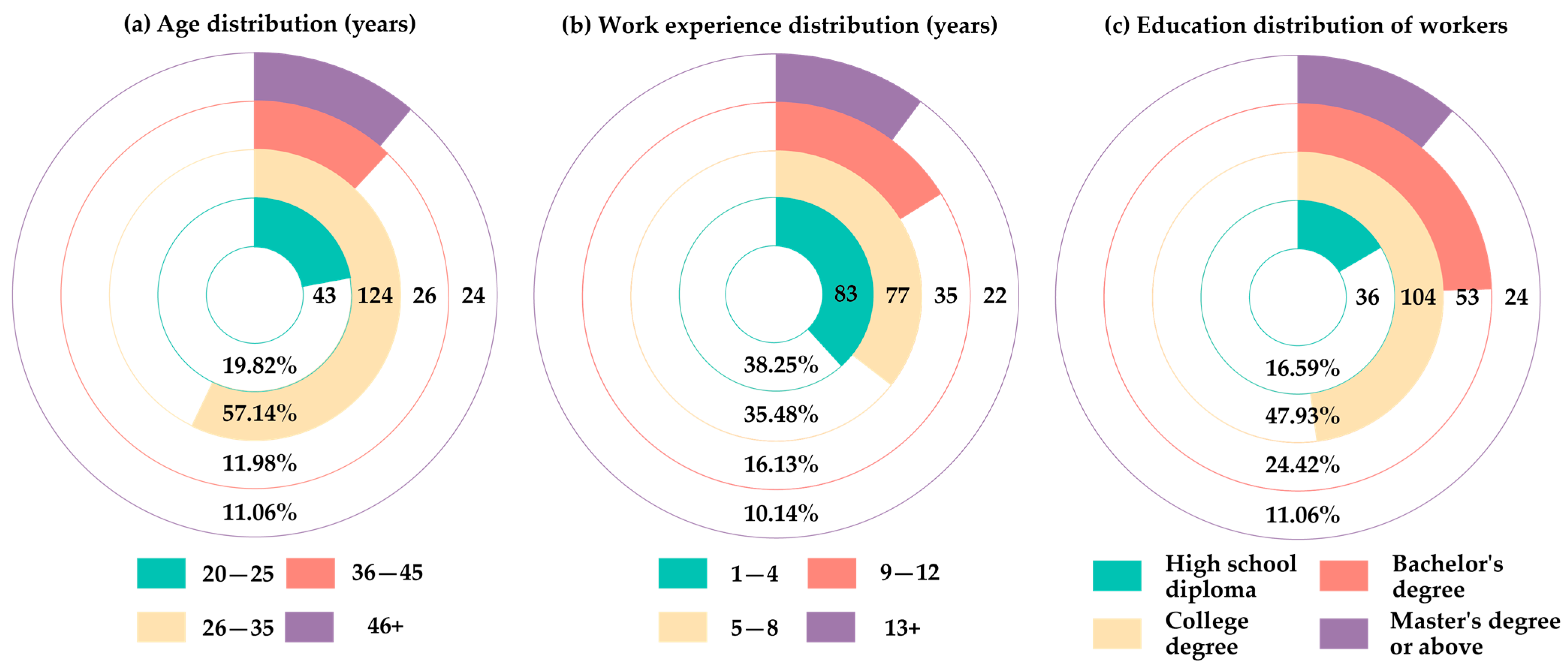
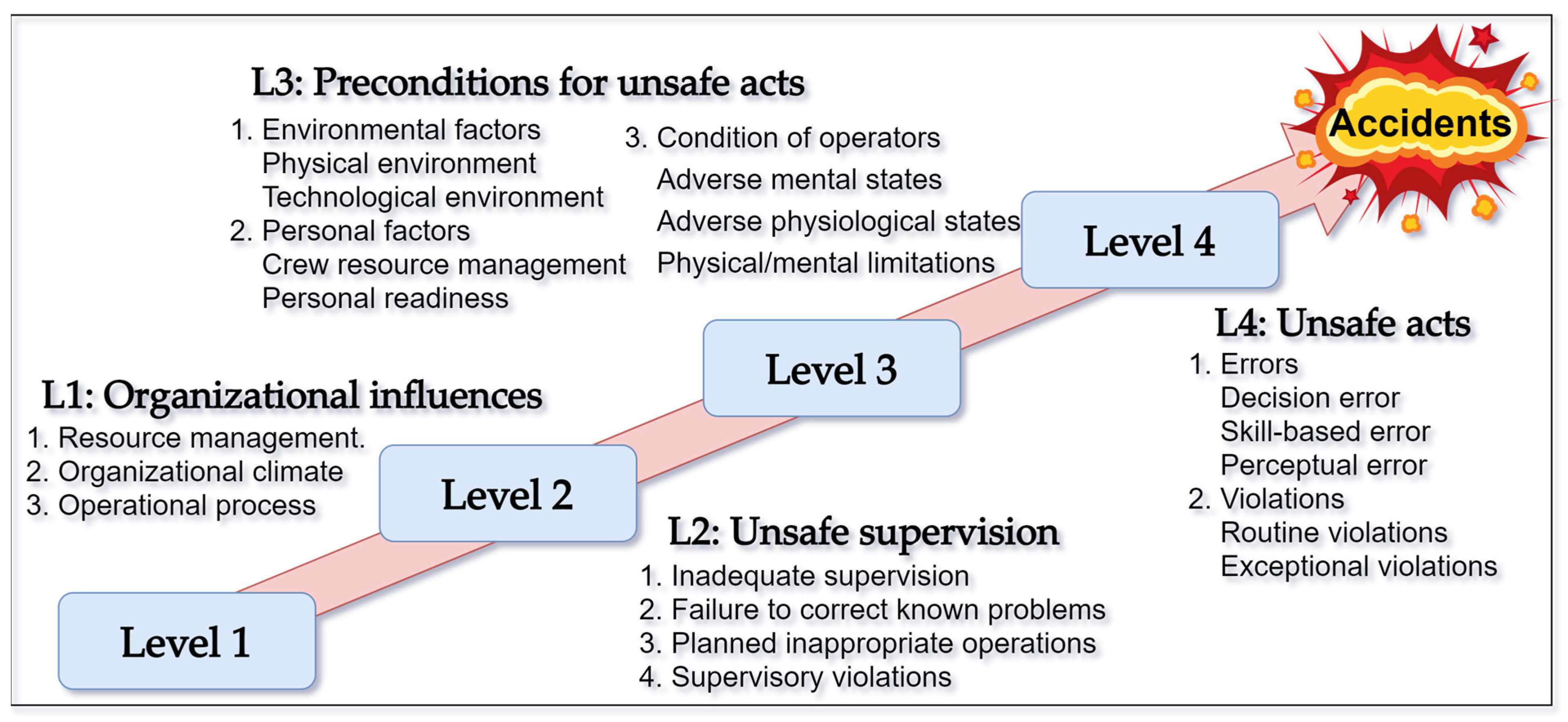
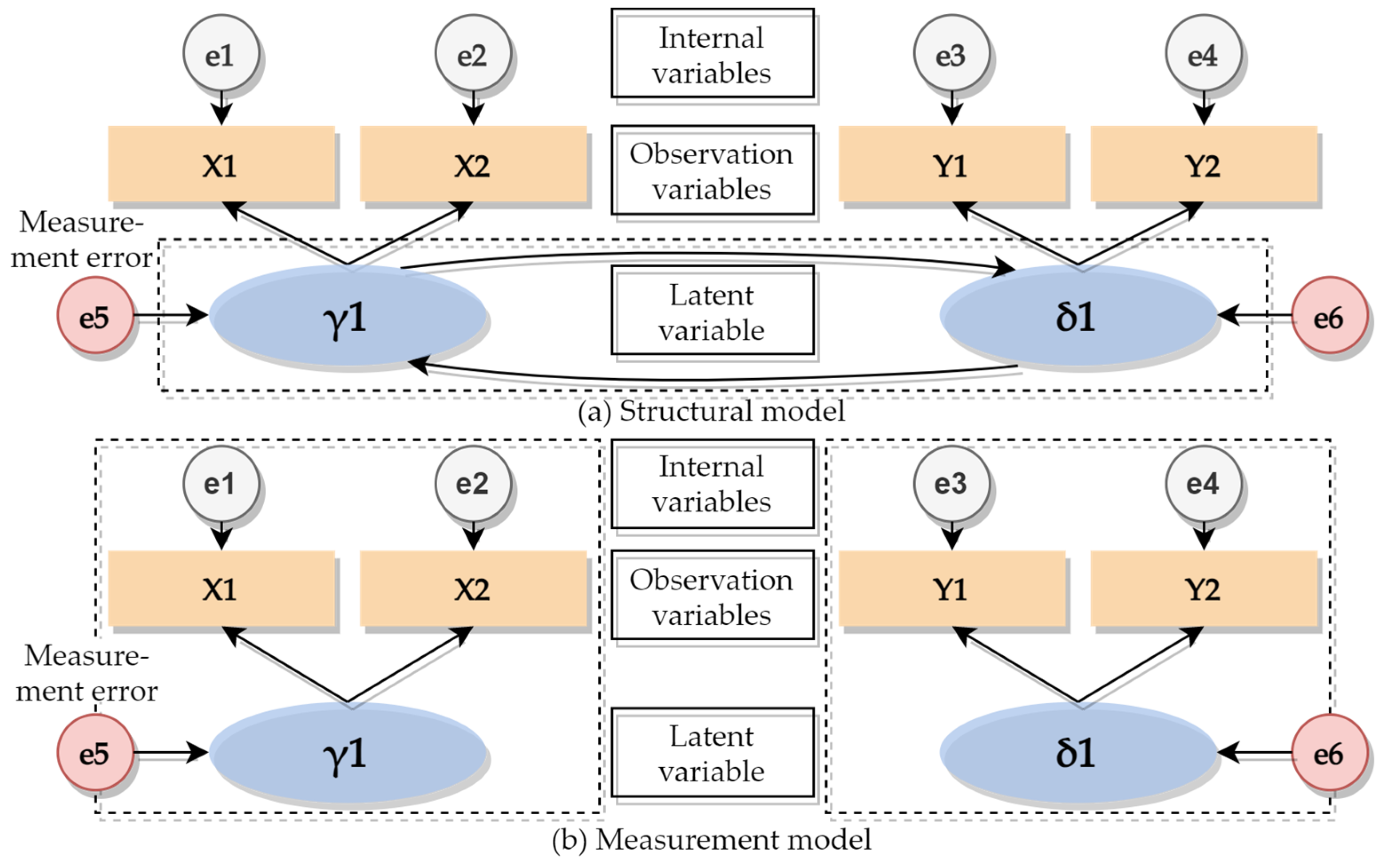

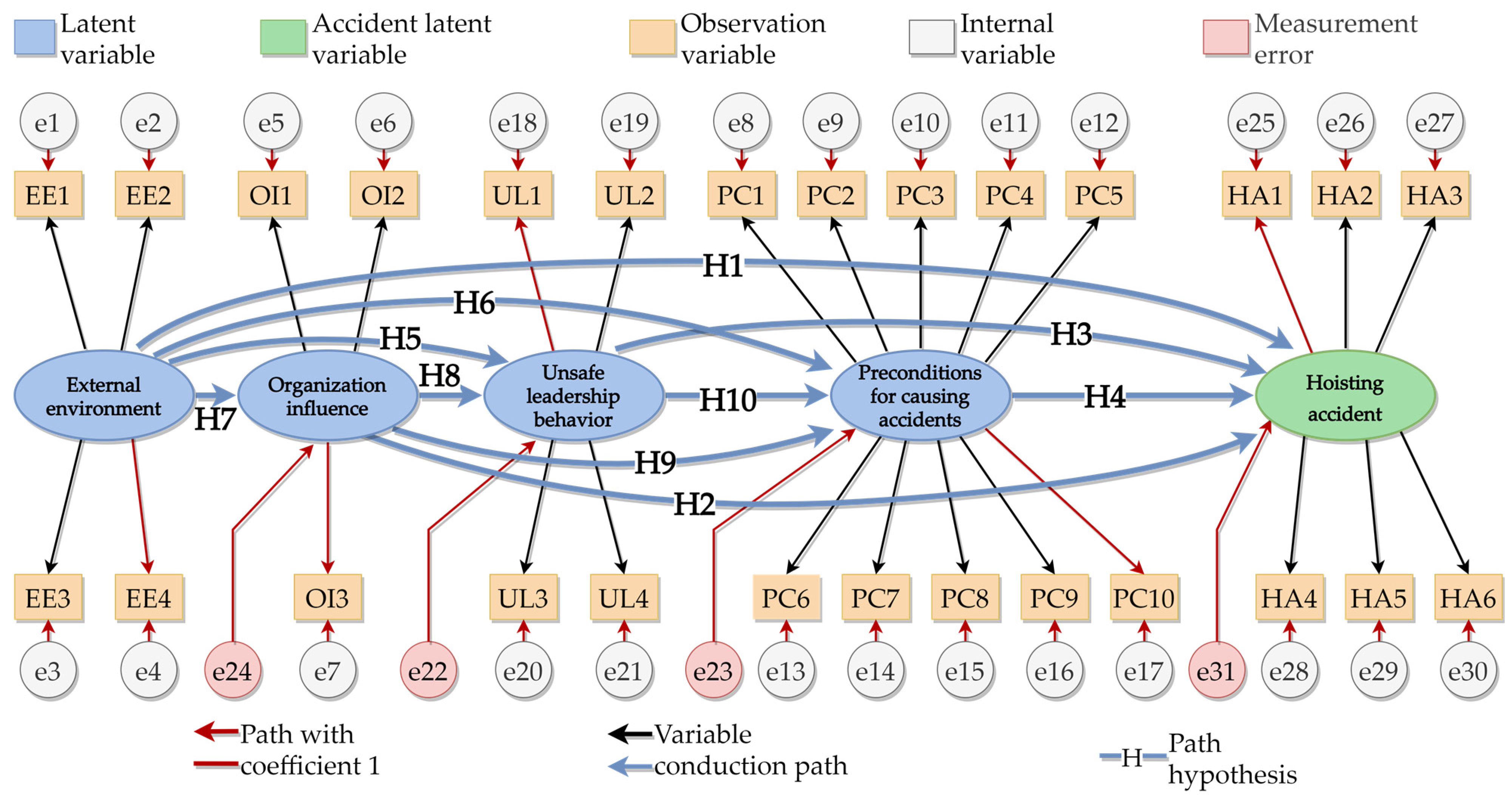

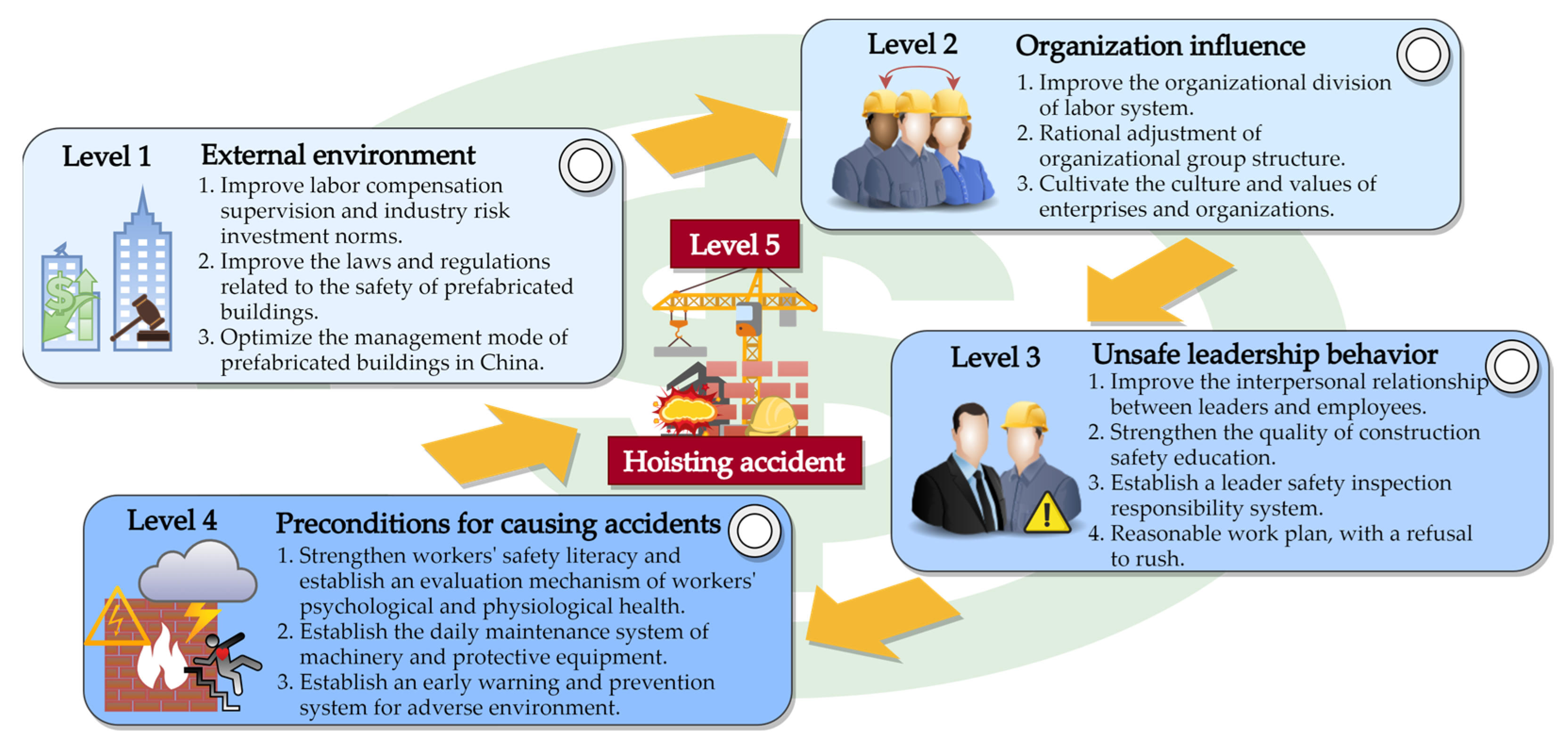
| Latent Variable | Variable Symbol | Observed Variable | Variable Symbol | Label | Point Range |
|---|---|---|---|---|---|
| External environment | EE | Economic factors | EE1 | e1 | One point to five points |
| Policy factors | EE2 | e2 | |||
| Industry management | EE3 | e3 | |||
| Historical factors | EE4 | e4 | |||
| Organization influence | OI | Management process | OI1 | e5 | |
| Organizational climate | OI2 | e6 | |||
| Resource management | OI3 | e7 | |||
| Unsafe leadership behaviors | UL | Inadequate supervision | UL1 | e8 | |
| Improper plan | UL2 | e9 | |||
| Failure to correct problems | UL3 | e10 | |||
| Violation of supervision | UL4 | e11 | |||
| Preconditions for causing accidents | PC | Professional level of workers | PC1 | e12 | |
| Mental state of workers | PC2 | e13 | |||
| Physiological state of workers | PC3 | e14 | |||
| Component production quality | PC4 | e15 | |||
| Strength of the connection point | PC5 | e16 | |||
| Hoisting equipment status | PC6 | e17 | |||
| Safety protection measures | PC7 | e18 | |||
| Operating conditions | PC8 | e19 | |||
| Rationality of the layout | PC9 | e20 | |||
| Component storage environment | PC10 | e21 | |||
| Hoisting accidents | HA | Falling from a height | HA1 | e22 | |
| Connection failure | HA2 | e23 | |||
| Pinch | HA3 | e24 | |||
| Mechanical failure | HA4 | e25 | |||
| Hoisting load dumping | HA5 | e26 | |||
| Hoisting load falls off | HA6 | e27 |
| Dimension | Cronbach’s α | CR | AVE |
|---|---|---|---|
| External environment | 0.876 | 0.9125 | 0.7229 |
| Organization influence | 0.780 | 0.8446 | 0.6446 |
| Unsafe leadership behaviors | 0.786 | 0.8437 | 0.5748 |
| Preconditions for causing accidents | 0.985 | 0.986 | 0.8756 |
| Hoisting accidents | 0.895 | 0.9188 | 0.655 |
| All indexes | 0.877 | - | - |
| Observed Variable | Variable Symbol | Validity Test Value | Observed Variable | Variable Symbol | Validity Test Value |
|---|---|---|---|---|---|
| Economic factors | EE1 | 0.670 | Component production quality | PC4 | 0.861 |
| Policy factors | EE2 | 0.768 | Strength of the connection point | PC5 | 0.804 |
| Industry management | EE3 | 0.794 | Hoisting equipment status | PC6 | 0.895 |
| Historical factors | EE4 | 0.721 | Safety protection measures | PC7 | 0.882 |
| Management process | OI1 | 0.738 | Operating conditions | PC8 | 0.863 |
| Organizational climate | OI2 | 0.727 | Rationality of the layout | PC9 | 0.924 |
| Resource management | OI3 | 0.687 | Component storage environment | PC10 | 0.845 |
| Inadequate supervision | UL1 | 0.665 | Falling from a height | HA1 | 0.761 |
| Improper plan | UL2 | 0.693 | Connection failure | HA2 | 0.761 |
| Failure to correct problems | UL3 | 0.620 | Pinch | HA3 | 0.737 |
| Violation of supervision | UL4 | 0.563 | Mechanical failure | HA4 | 0.597 |
| Professional level of workers | PC1 | 0.912 | Hoisting load dumping | HA5 | 0.495 |
| Mental state of workers | PC2 | 0.942 | Hoisting load falls off | HA6 | 0.655 |
| Physiological state of workers | PC3 | 0.930 |
| Weights | Covariances | Variances | Total | |
|---|---|---|---|---|
| Fixed | 36 | 0 | 0 | 36 |
| Unfixed | 32 | 4 | 32 | 68 |
| Total | 68 | 4 | 32 | 104 |
| Index Name | Acceptable Range | Supporting Literature | Fit Value |
|---|---|---|---|
| x2/df | ≤3.00 good fit | [55,56,57] | 2.131 |
| GFI (goodness of fit) | >0.80 good fit | [55,56,57] | 0.849 |
| AGFI (adjusted goodness of fit) | >0.80 good fit | [55,57] | 0.818 |
| IFI (incremental fit index) | >0.90 good fit | [55,57] | 0.949 |
| TLI (Tucker–Lewis index) | >0.90 good fit | [55,57] | 0.942 |
| CFI (comparative fit index) | >0.90 good fit | [55,57] | 0.948 |
| RMSEA (root-mean-square error approximation) | <0.05 good fit | [55,57] | 0.065 |
| <0.08 fair fit | |||
| <0.10 normal fit | |||
| RMR (standardized root-mean-square residual) | <0.05 good fit | [55,56,57] | 0.047 |
| <0.08 fair fit |
| Label | Estimate | S.E. | C.R. | p | Label | Estimate | S.E. | C.R. | p |
|---|---|---|---|---|---|---|---|---|---|
| EE | 0.586 | 0.077 | 7.658 | *** | e16 | 0.105 | 0.011 | 9.908 | *** |
| e1 | 0.387 | 0.038 | 10.098 | *** | e17 | 0.232 | 0.021 | 10.895 | *** |
| e2 | 0.306 | 0.040 | 7.602 | *** | e18 | 0.492 | 0.063 | 7.827 | *** |
| e3 | 0.239 | 0.036 | 6.708 | *** | e19 | 0.426 | 0.077 | 5.519 | *** |
| e4 | 0.477 | 0.051 | 9.389 | *** | e20 | 0.540 | 0.058 | 9.382 | *** |
| e5 | 0.330 | 0.092 | 3.584 | *** | e21 | 0.799 | 0.085 | 9.411 | *** |
| e6 | 0.586 | 0.077 | 7.658 | *** | e22 | 0.365 | 0.080 | 4.580 | *** |
| e7 | 0.617 | 0.093 | 6.618 | *** | e23 | 0.970 | 0.102 | 9.474 | *** |
| e8 | 0.119 | 0.012 | 9.985 | *** | e24 | 0.542 | 0.114 | 4.755 | *** |
| e9 | 0.069 | 0.008 | 9.125 | *** | e25 | 0.351 | 0.042 | 8.266 | *** |
| e10 | 0.080 | 0.008 | 9.680 | *** | e26 | 0.271 | 0.033 | 8.150 | *** |
| e11 | 0.163 | 0.015 | 10.789 | *** | e27 | 0.396 | 0.044 | 9.087 | *** |
| e12 | 0.269 | 0.024 | 11.088 | *** | e28 | 0.532 | 0.051 | 10.490 | *** |
| e13 | 0.119 | 0.012 | 10.339 | *** | e29 | 0.612 | 0.056 | 10.973 | *** |
| e14 | 0.164 | 0.015 | 10.579 | *** | e30 | 0.582 | 0.057 | 10.233 | *** |
| e15 | 0.204 | 0.019 | 10.795 | *** | e31 | 1.030 | 0.119 | 8.653 | *** |
| Routing | Estimate | S.E. | C.R. | p | Routing | Estimate | S.E. | C.R. | p |
|---|---|---|---|---|---|---|---|---|---|
| OI←EE | 0.183 | 0.067 | 2.729 | 0.006 | PC3←PC | 0.983 | 0.034 | 29.331 | *** |
| UL←EE | 0.109 | 0.062 | 1.743 | 0.081 | PC4←PC | 0.920 | 0.036 | 25.278 | *** |
| UL←OI | 0.561 | 0.110 | 5.097 | *** | PC5←PC | 0.926 | 0.042 | 22.302 | *** |
| PC←UL | 0.112 | 0.125 | 0.892 | 0.373 | PC6←PC | 0.972 | 0.035 | 27.550 | *** |
| PC←OI | 0.249 | 0.125 | 1.991 | 0.047 | PC7←PC | 1.006 | 0.038 | 26.263 | *** |
| PC←EE | 0.028 | 0.082 | 0.345 | 0.730 | PC8←PC | 1.006 | 0.040 | 25.122 | *** |
| HA←OI | −0.019 | 0.134 | −0.139 | 0.890 | PC9←PC | 1.065 | 0.037 | 28.953 | *** |
| HA←PC | −0.110 | 0.067 | −1.644 | 0.100 | PC10←PC | 1.000 | |||
| HA←UL | 0.175 | 0.134 | 1.311 | 0.190 | UL1←UL | 1.000 | |||
| HA←EE | −0.055 | 0.087 | −0.626 | 0.531 | UL2←UL | 1.131 | 0.122 | 9.280 | *** |
| EE1←EE | 0.746 | 0.064 | 11.652 | *** | UL3←UL | 0.785 | 0.086 | 9.090 | *** |
| EE2←EE | 1.089 | 0.077 | 14.112 | *** | UL4←UL | 0.879 | 0.101 | 8.698 | *** |
| EE3←EE | 1.066 | 0.075 | 14.314 | *** | HA1←HA | 1.000 | |||
| EE4←EE | 1.000 | HA2←HA | 0.893 | 0.048 | 18.724 | *** | |||
| OI1←OI | 1.124 | 0.164 | 6.857 | *** | HA3←HA | 0.918 | 0.054 | 17.016 | *** |
| OI2←OI | 0.884 | 0.095 | 9.331 | *** | HA4←HA | 0.702 | 0.053 | 13.134 | *** |
| OI3←OI | 1.000 | HA5←HA | 0.547 | 0.054 | 10.185 | *** | |||
| PC1←PC | 1.084 | 0.038 | 28.543 | *** | HA6←HA | 0.782 | 0.058 | 13.604 | *** |
| PC2←PC | 1.038 | 0.034 | 30.248 | *** |
| Routing | Estimate (Standardized) | Routing | Estimate (Standardized) |
|---|---|---|---|
| OI←EE | 0.201 | PC3←PC | 0.942 |
| UL←EE | 0.119 | PC4←PC | 0.918 |
| UL←OI | 0.560 | PC5←PC | 0.876 |
| PC←UL | 0.083 | PC6←PC | 0.944 |
| PC←OI | 0.184 | PC7←PC | 0.930 |
| PC←EE | 0.023 | PC8←PC | 0.915 |
| HA←OI | −0.014 | PC9←PC | 0.948 |
| HA←PC | −0.109 | PC10←PC | 0.904 |
| HA←UL | 0.128 | UL1←UL | 0.731 |
| HA←EE | −0.044 | UL2←UL | 0.793 |
| EE1←EE | 0.703 | UL3←UL | 0.627 |
| EE2←EE | 0.851 | UL4←UL | 0.595 |
| EE3←EE | 0.874 | HA1←HA | 0.866 |
| EE4←EE | 0.766 | HA2←HA | 0.870 |
| OI1←OI | 0.827 | HA3←HA | 0.832 |
| OI2←OI | 0.655 | HA4←HA | 0.703 |
| OI3←OI | 0.691 | HA5←HA | 0.583 |
| PC1←PC | 0.934 | HA6←HA | 0.725 |
| PC2←PC | 0.930 |
| Standardized Direct Influence Effect Values | |||||
|---|---|---|---|---|---|
| EE | OI | UL | PC | HA | |
| OI | 0 | 0 | 0 | 0 | 0 |
| UL | 0.113 | 0 | 0 | 0 | 0 |
| PC | 0.056 | 0.046 | 0 | 0 | 0 |
| HA | 0.018 | 0.045 | 0.009 | 0 | 0 |
| Standardized Indirect Influence Effect Values | |||||
| EE | OI | UL | PC | HA | |
| OI | 0.183 | 0 | 0 | 0 | 0 |
| UL | 0.098 | 0.561 | 0 | 0 | 0 |
| PC | 0.041 | 0.266 | 0.112 | 0 | 0 |
| HA | 0.014 | 0.002 | 0.154 | 0.110 | 0 |
| Total Impact Effect Values | |||||
| EE | OI | UL | PC | HA | |
| OI | 0.183 | 0 | 0 | 0 | 0 |
| UL | 0.211 | 0.561 | 0 | 0 | 0 |
| PC | 0.097 | 0.312 | 0.112 | 0 | 0 |
| HA | 0.032 | 0.047 | 0.163 | 0.110 | 0 |
Publisher’s Note: MDPI stays neutral with regard to jurisdictional claims in published maps and institutional affiliations. |
© 2022 by the authors. Licensee MDPI, Basel, Switzerland. This article is an open access article distributed under the terms and conditions of the Creative Commons Attribution (CC BY) license (https://creativecommons.org/licenses/by/4.0/).
Share and Cite
Song, Y.; Wang, J.; Liu, D.; Guo, F. Study of Occupational Safety Risks in Prefabricated Building Hoisting Construction Based on HFACS-PH and SEM. Int. J. Environ. Res. Public Health 2022, 19, 1550. https://doi.org/10.3390/ijerph19031550
Song Y, Wang J, Liu D, Guo F. Study of Occupational Safety Risks in Prefabricated Building Hoisting Construction Based on HFACS-PH and SEM. International Journal of Environmental Research and Public Health. 2022; 19(3):1550. https://doi.org/10.3390/ijerph19031550
Chicago/Turabian StyleSong, Yinghui, Junwu Wang, Denghui Liu, and Feng Guo. 2022. "Study of Occupational Safety Risks in Prefabricated Building Hoisting Construction Based on HFACS-PH and SEM" International Journal of Environmental Research and Public Health 19, no. 3: 1550. https://doi.org/10.3390/ijerph19031550
APA StyleSong, Y., Wang, J., Liu, D., & Guo, F. (2022). Study of Occupational Safety Risks in Prefabricated Building Hoisting Construction Based on HFACS-PH and SEM. International Journal of Environmental Research and Public Health, 19(3), 1550. https://doi.org/10.3390/ijerph19031550







